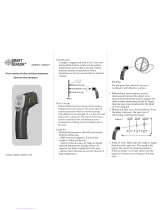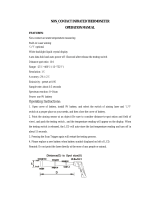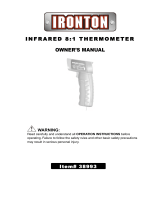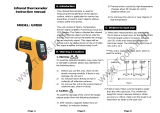Fluke Models: 63 Mini Infrared Thermometer Gun User manual
- Category
- Freezers
- Type
- User manual
This manual is also suitable for

®
PN 2149032
September 2004 Rev. 3, 6/09
© 2004-2009 Fluke Corporation. All rights reserved. Printed in China.
Specifications are subject to change without notice.
All product names
are trademarks of their respective companies.
63/66/68
Infrared Thermometers
Users Manual

LIMITED WARRANTY AND LIMITATION OF LIABILITY
This Fluke product will be free from defects in material and
workmanship for two years from the date of purchase. This
warranty does not cover fuses, disposable batteries, or
damage from accident, neglect, misuse, alteration, con-
tamination, or abnormal conditions of operation or handling.
Resellers are not authorized to extend any other warranty
on Fluke’s behalf. To obtain service during the warranty
period, contact your nearest Fluke authorized service cen-
ter to obtain return authorization information, then send the
product to that Service Center with a description of the
problem.
THIS WARRANTY IS YOUR ONLY REMEDY. NO OTHER
WARRANTIES, SUCH AS FITNESS FOR A PARTICULAR
PURPOSE, ARE EXPRESSED OR IMPLIED. FLUKE IS
NOT LIABLE FOR ANY SPECIAL, INDIRECT, INCIDEN-
TAL OR CONSEQUENTIAL DAMAGES OR LOSSES,
ARISING FROM ANY CAUSE OR THEORY. Since some
states or countries do not allow the exclusion or limitation of
an implied warranty or of incidental or consequential dam-
ages, this limitation of liability may not apply to you.
Fluke Corporation
P.O. Box 9090
Everett, WA 98206-9090
U.S.A.
Fluke Europe B.V.
P.O. Box 1186
5602 BD Eindhoven
The Netherlands
11/99

i
Table of Contents
Title Page
Introduction....................................................... 1
Contacting Fluke .............................................. 1
Safety Information ............................................ 2
Symbols and Safety Markings........................ 3
Features ........................................................... 5
Display ............................................................. 7
Display (63).................................................... 8
Display (66/68)............................................... 8
Buttons (66/68)................................................. 9
How the Thermometers Work........................... 9
Operating the Thermometer ............................. 10
Temperature Measurement............................ 10
Locating a Hot or Cold Spot........................... 10
Distance and Spot Size.................................. 11
Field of View .................................................. 13
Emissivity....................................................... 13
Switching °C and °F....................................... 15
Trigger Lock (66/68)....................................... 15
Backlight and Laser On/Off Switch (63) ......... 16
Function Button Functions (66/68) ................. 16
Selecting a Function (66/68) .......................... 17
Setting the High Alarm, Low Alarm, and
Emissivity (66/68)........................................... 18

63/66/68
Infrared Thermometers
ii
Using a Contact Temperature Probe (PRB)
(66/68) ........................................................... 18
HOLD ............................................................ 19
Storing Data (66/68) ...................................... 19
Recalling Data (66/68)................................... 19
LOG Clear Function....................................... 19
Maintenance .................................................... 20
Changing the Battery..................................... 20
Cleaning the Lens.......................................... 20
Cleaning the Housing .................................... 20
Troubleshooting ............................................... 21
Accessories...................................................... 21
CE Certification................................................ 22
Specifications................................................... 22

1
63/66/68
Introduction
The Fluke Models 63, 66, and 68 Infrared Thermometers (“the
thermometers”) are for non-contact temperature measurement.
These thermometers determine an object’s surface temperature by
measuring the amount of infrared energy radiated by the object’s
surface. See Figure 2.
Contacting Fluke
To contact Fluke, call one of the following telephone numbers:
• Technical Support USA: 1-800-44-FLUKE (1-800-443-5853)
• Calibration/Repair USA: 1-888-99-FLUKE (1-888-993-5853)
• Canada: 1-800-36-FLUKE (1-800-363-5853)
• Europe: +31 402-675-200
• Japan: +81-3-3434-0181
• Singapore: +65-738-5655
• Anywhere in the world: +1-425-446-5500
Or, visit Fluke's website at www.fluke.com
.
To register your product, visit http://register.fluke.com
.
To view, print, or download the latest manual supplement, visit
http://us.fluke.com/usen/support/manuals
.

63/66/68
Infrared Thermometers
2
Safety Information
XW Warning
A Warning identifies conditions and actions that pose
hazards to the user. To avoid electrical shock or personal
injury, follow these guidelines:
• * Do not point laser directly at eye or indirectly off
reflective surfaces.
• Before using the thermometer inspect the case. Do not
use the thermometer if it appears damaged. Look for
cracks or missing plastic.
• Replace the batteries as soon as the battery indicator
( ) appears.
• Do not use the thermometer if it operates abnormally.
Protection may be impaired. When in doubt, have the
thermometer serviced.
• Do not operate the thermometer around explosive gas,
vapor, or dust.
• Do not connect the optional external probe to live
electrical circuits.
• To avoid a burn hazard, remember that highly reflective
objects will result in lower than actual temperature
measurements.
• Do not use in a manner not specified by this manual or
the protection supplied by the equipment may be
impaired.
W Caution
To avoid damaging the thermometer or the equipment
under test protect them from the following:
• EMF (electro-magnetic fields) from arc welders,
induction heaters, etc.
• Static electricity
• Thermal shock (caused by large or abrupt ambient
temperature changes - allow 30 minutes for
thermometer to stabilize before use).
• Do not leave the thermometer on or near objects of
high temperature.

63/66/68
Safety Information
3
Symbols and Safety Markings
Table 1 and Figure 1 show various symbols and safety markings
that are on the thermometers and in this manual.
Table 1. Symbols
Symbol Explanation
W
Risk of danger. Important information. See Manual.
X
Hazardous voltage. Precedes warning
*
Warning. Laser.
P
Conforms to requirements of European Union and
European Free Trade Association (EFTA)
°C
Celsius
°F
Fahrenheit
M
Battery
~
Do not dispose of this product as unsorted
municipal waste. Go to Fluke’s website for recycling
information.

63/66/68
Infrared Thermometers
4
CAUTION
L
A
S
E
R
R
A
D
I
A
T
I
O
N
-
D
O
N
O
T
S
T
A
R
E
I
N
T
O
B
E
A
M
C
L
A
S
S
2
(
I
I
)
L
A
S
E
R
P
R
O
D
U
C
T
O
U
T
P
U
T
<
1
m
W
W
A
V
E
L
E
N
G
T
H
6
3
0
-
6
7
0
n
m
C
o
m
p
l
i
e
s
w
i
t
h
F
D
A
2
1
C
F
R
1
0
4
0
.
1
0
a
n
d
1
0
4
0
.
1
1
O
N
O
F
F
63
66/68
MADE IN CHINA
MFG DATE: Dec 29, 2004
SERIAL #: 2421540101-0070
9V NEDA 1604
LASER / LIGHT
˚C ˚F OFF ON
MADE IN CHINA
MFG DATE: Dec 29, 2004
SERIAL #: 2423260201-0030
9V NEDA 1604
LOCK
˚C ˚F OFF ON
ame0010.eps
Figure 1. Safety Markings on the Thermometers

63/66/68
Features
5
Features
The thermometers include:
• Single-spot laser sighting
• MAX temperature display
• Backlit display
• Durable, ergonomic construction
• Tripod mount
• Hard case and wrist strap
• MAX, MIN, DIF, AVG temperature displays (66/68)
• Adjustable emissivity (66/68)
• High and low alarm (66/68)
• Data logging (66/68)
• Trigger Lock (66/68)
• Contact probe jack (66/68)

63/66/68
Infrared Thermometers
6
Display
(66/68 shown)
63: Backlight On/Off
66/68: Trigger
Lock On/Off
Battery Cover
Trigger
Battery Door
Release Button
Laser
ame007.eps
Figure 2. Infrared Thermometer

63/66/68
Display
7
Display
A
B
C
D
E
F
G
H
I
J
ame001.eps
A
Backlight “On” symbol (63/66/68)
B
°C/°F symbol (Celsius/Fahrenheit) (63/66/68)
C
High alarm and low alarm symbol (66/68)
D
Maximum temperature display (63)
Temperature values for the MAX, MIN, DIF, AVG, HAL,
LAL, PRB (66/68)
E
Icon for MAX (63/66/68)
Icon for MIN, DIF, AVG, HAL, LAL, PRB (66/68)
F
LOG icon shows log mode for data storage (66/68)
G
Live temperature value (63/66/68)
H
SCAN or HOLD (63/66/68)
I
Emissivity symbol and value (63/66/68)
J
Low Battery and Laser “On” symbols (63/66/68)
Lock symbol (66/68)

63/66/68
Infrared Thermometers
8
Display (63)
In the SCAN mode, the backlit reading displays both the live
temperature (G) and maximum temperature (D) in Celsius or
Fahrenheit (B). The thermometer holds the last reading for 7
seconds after the trigger is released and “HOLD” appears (H).
Display (66/68)
In SCAN mode, both the live temperature (G) and the selected
mode function (D,E) are displayed in Celsius or Fahrenheit (B).
The thermometer holds the last reading for 7 seconds after the
trigger is released and “HOLD” appears (H).
Notes
For all units, when the battery is low,
appears but the
thermometer will no longer function.
For the 66/68, to activate the laser and backlight, pull the
trigger. Press
once to activate the backlight, twice to
turn both laser and backlight on, and a third time to turn
them off.

63/66/68
Buttons (66/68)
9
Buttons (66/68)
Sets high and low alarm
Up and down
Cycles through the function loop
Laser/Backlight on/off button (pull trigger
and press button to activate
laser/backlight)
LOG button (for storing data)
How the Thermometers Work
Infrared thermometers measure the surface temperature of an
opaque object. The thermometer’s optics sense emitted, reflected,
and transmitted energy, which is collected and focused onto a
detector. The unit’s electronics translate the information into a
temperature reading which the unit displays. The laser is used for
aiming purposes only. See Figure 3.

63/66/68
Infrared Thermometers
10
Reflected energy
Emitted
Energy
Transmitted energy
Target
ame002.eps
Figure 3. How the Thermometer Works
Operating the Thermometer
Temperature Measurement
To measure temperature, point the unit at an object and pull the
trigger. Be sure to consider distance-to-spot size ratio and field of
view. The laser is used for aiming only.
Locating a Hot or Cold Spot
To find a hot or cold spot, aim the thermometer outside the desired
area. Then, slowly scan across the area with an up and down
motion until you locate the hot or cold spot. See Figure 4.

63/66/68
Operating the Thermometer
11
ame003.eps
Figure 4. Locating a Hot or Cold Spot
Distance and Spot Size
As the distance (D) from the object being measured increases, the
spot size (S) of the area measured by the unit becomes larger. The
relationship between distance and spot size for each unit is shown
in Figure 5. The focal point of each unit is 914 mm (36 in). The spot
sizes indicate 90 % encircled energy. See Figure 5.

63/66/68
Infrared Thermometers
12
63
D:S=12:1
38 mm @
300 mm
75 mm @
900 mm
132 mm @
1500 mm
1.5 " @
12 "
3 " @
36 "
5.3 " @
60 "
S
D
66
D:S=30:1
24 mm @
300 mm
30 mm @
900 mm
62 mm @
1500 mm
0.9 " @
12 "
1.2 " @
36 "
2.5 " @
60 "
D
S
68
D:S=50:1
19 mm @
300 mm
18 mm @
900 mm
42 mm @
1500 mm
0.8 " @
12 "
0.7 " @
36 "
1.7 " @
60 "
D
S
ame005.eps
Figure 5. Distance and Spot Size

63/66/68
Operating the Thermometer
13
Field of View
Make sure that the target is larger than the unit’s spot size. The
smaller the target, the closer you should be to it. See Figure 6.
ame004.eps
Figure 6. Field of View
Emissivity
Emissivity describes the energy-emitting characteristics of
materials. Most organic materials and painted or oxidized surfaces
have an emissivity of 0.95.
The 63 has a preset emissivity of 0.95. To compensate for
inaccurate readings that may result from measuring shiny metal
surfaces, cover the surface to be measured with masking tape or
flat black paint (<148 °C/300 °F). Allow time for the tape or paint to

63/66/68
Infrared Thermometers
14
reach the same temperature as the surface beneath it. Measure
the temperature of the tape or painted surface.
The 66/68 thermometers allow you to adjust the unit’s emissivity for
the type of surface being measured. Refer to Table 2.
Table 2. Surface Emissivity
Measured Surface Emissivity Measured Surface Emissivity
METALS Iron
Aluminum
Oxidized 0.5-0.9
Oxidized 0.2-0.4 Rusted 0.5-0.7
Alloy A3003 Iron, Cast
Oxidized 0.3 Oxidized 0.6-0.95
Roughened 0.1-0.3 Unoxidized 0.2
Brass Molten 0.2-0.3
Burnished 0.3 Iron, Wrought
Oxidized 0.5 Dull 0.9
Copper Lead
Oxidized 0.4-0.8 Rough 0.4
Electrical Terminal
Blocks
0.6 Oxidized 0.2-0.6
Haynes Molybdenum
Alloy 0.3-0.8 Oxidized 0.2-0.6
Inconel Nickel
Oxidized 0.7-0.95 Oxidized 0.2-0.5
Sandblasted 0.3-0.6 Platinum
Electoropolished 0.15 Black 0.9

63/66/68
Operating the Thermometer
15
Table 2. Surface Emissivity (cont.)
Measured Surface Emissivity Measured Surface Emissivity
Steel Clay 0.95
Cold-Rolled 0.7-0.9
Concrete 0.95
Ground Sheet 0.4-0.6
Cloth 0.95
Polished Sheet 0.1
Glass
Zinc
Plate 0.85
Oxidized 0.1
Gravel 0.95
NON-METALS
Gypsum 0.8-0.95
Asbestos 0.95
Ice 0.98
Asphalt 0.95
Limestone 0.98
Basalt 0.7
Paper
(any color) 0.95
Carbon
Plastic
Unoxidized 0.8-0.9
Opaque 0.95
Graphite 0.7-0.8
Soil 0.9-0.98
Carborundum 0.9
Water 0.93
Ceramic 0.95
Wood (natural) 0.9-0.95
Switching
°
C and
°
F
Open the unit by pushing the button on the underside of the
thermometer near the trigger and pulling down and forward at the
top of the handle.
To toggle between °C and °F, slide the top switch to the
appropriate position. See Figure 2.

63/66/68
Infrared Thermometers
16
Trigger Lock (66/68)
To lock the unit on for continuous measurement, slide the bottom
switch down. See Figure 2. If the trigger is pulled while the unit is
locked on, the laser and backlight will turn on if they have been
activated. When the unit is locked on, the laser will turn off when
the trigger is released. However, the backlight remains on unless it
is turned off using the keypad.
Backlight and Laser On/Off Switch (63)
To turn the backlight and laser on or off, slide the backlight and
laser switch to the appropriate position. See Figure 2.
Function Button Functions (66/68)
Models 66 and 68 measure Maximum (MAX), Minimum (MIN),
Differential (DIF), and Average (AVG) temperatures each time a
reading is taken. DIF shows the difference between maximum and
minimum temperatures measured. AVG shows the average
temperature reading for each time the trigger is pulled or the unit is
locked on. This data is stored and can be recalled with
until a
new measurement is taken. See “Hold” for information on how to
recall stored data. When the trigger is pulled again, the unit will
being measuring in the last mode selected.
Pressing
also allows access to the High Alarm (HAL), Low
Alarm (LAL), Emissivity (EMS), Probe temperature (PRB-only
available when the probe is connected to the thermometer), and
Data logger (LOG). Each time
is pressed the unit advances the
function cycle. Figure 7 shows the sequence of functions in the
function cycle.
Page is loading ...
Page is loading ...
Page is loading ...
Page is loading ...
Page is loading ...
Page is loading ...
Page is loading ...
Page is loading ...
-
 1
1
-
 2
2
-
 3
3
-
 4
4
-
 5
5
-
 6
6
-
 7
7
-
 8
8
-
 9
9
-
 10
10
-
 11
11
-
 12
12
-
 13
13
-
 14
14
-
 15
15
-
 16
16
-
 17
17
-
 18
18
-
 19
19
-
 20
20
-
 21
21
-
 22
22
-
 23
23
-
 24
24
-
 25
25
-
 26
26
-
 27
27
-
 28
28
Fluke Models: 63 Mini Infrared Thermometer Gun User manual
- Category
- Freezers
- Type
- User manual
- This manual is also suitable for
Ask a question and I''ll find the answer in the document
Finding information in a document is now easier with AI
Related papers
-
Fluke PN 4060712 User manual
-
Fluke Models: 62 MAX Mini Infrared Thermometer User manual
-
Fluke 568 User manual
-
Fluke InsideIR Software User manual
-
Fluke 561R User manual
-
Fluke Thermometer 80T-IR User manual
-
Fluke Models: 572-2 High Temperature Infrared Thermometer User manual
-
Fluke 561S User manual
-
Fluke 561 User manual
-
Fluke 572 User manual
Other documents
-
 Smart Sensor AR330+ User manual
Smart Sensor AR330+ User manual
-
 AMPD ST350 Operating instructions
AMPD ST350 Operating instructions
-
 WINTACT WT320 User manual
WINTACT WT320 User manual
-
 Ironton Infrared 8:1 Thermometer Owner's manual
Ironton Infrared 8:1 Thermometer Owner's manual
-
Traceable 4364 Owner's manual
-
Traceable 4364 Operating instructions
-
 Benetech GM320 User manual
Benetech GM320 User manual
-
GYS Infrared Thermometer Owner's manual
-
Traceable 2-in-1 Waterproof Food HACCP Thermometer User manual
-
Traceable Infrared Thermometer User manual
































